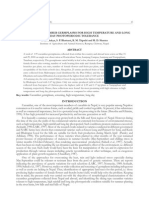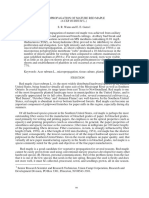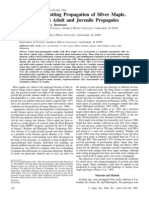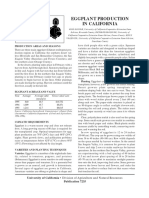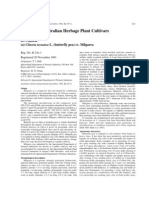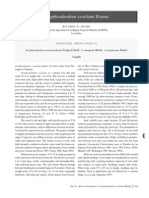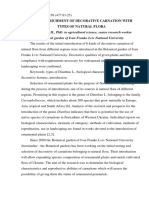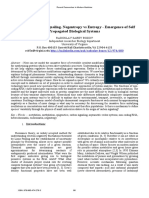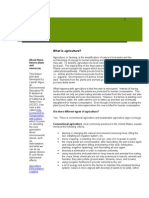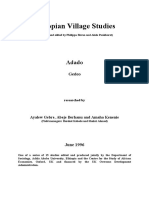Tmp6e5 TMP
Tmp6e5 TMP
Uploaded by
FrontiersCopyright:
Available Formats
Tmp6e5 TMP
Tmp6e5 TMP
Uploaded by
FrontiersOriginal Title
Copyright
Available Formats
Share this document
Did you find this document useful?
Is this content inappropriate?
Copyright:
Available Formats
Tmp6e5 TMP
Tmp6e5 TMP
Uploaded by
FrontiersCopyright:
Available Formats
CULTIVAR & GERMPLASM RELEASES
HORTSCIENCE 38(7):14461447. 2003.
Diamond Bay and Emerald Bay
Aglaonema
R.J. Henny, J. Chen, and D.J. Norman
University of Florida, Institute of Food and Agricultural Science, Mid-Florida
Research and Education Center, 2725 Binion Road, Apopka, FL 32703
Additional index words. Aglaonema commutatum, Aglaonema nitidum, chinese evergreen,
foliage plant, foliage plant production, plant breeding
Aglaonema cultivars (family Araceae),
commonly called Chinese evergreens are
important ornamental tropical foliage plants
because they can readily adapt to the low light
and low relative humidity levels encountered
under interior conditions. Historically, most
new Aglaonema cultivars were introduced
directly from the wild or were sports selected
from established cultivars. Control of Aglaonema owering (Henny, 1983) and development of pollination techniques (Henny, 1985)
has led to the production of many new cultivars
in the past fteen years by both public and private breeders. Aglaonema Silver Bay(Henny
et al., 1992) and A. Golden Bay (Henny and
Chen, 2001) were interspecic hybrids developed in the foliage plant breeding program of
the Florida Agricultural Experiment Station
at the Mid-Florida Research and Education
Center (MREC)Apopka. Silver Bay and
Golden Bay are very popular cultivars because of their beautiful foliage, good growth
habit and excellent performance in interior
conditions. Commercially, tissue culture
propagation has been used to speed release
of these hybrids to producers.
Origin
Aglaonema Diamond Baywas a mutation
found among a population of tissue-cultured
Aglaonema Silver Bay plants, while Aglaonema Emerald Bay was discovered within
a group of tissue-cultured Aglaonema Golden
Bay. The original Diamond Bay mutation
was noticed because it lacked one of the
foliar variegation patterns normally present
in Silver Bay, whereas Emerald Bay was
selected because it lacked the yellow background coloration present in normal Golden
Bay leaves and petioles. The selections were
taken to MREC, increased by stem cuttings
and observed for stability. Both selections remained stable while each maintained its new
foliar pattern and other desirable traits of their
parents. Therefore these cultivars have been
selected for release.
long. Leaf margins are entire and the lamina on
either side of the midrib tends to be of slightly
unequal widths, resulting in some curving of
the blade towards the narrower side. Leaves
exhibit a central grey-green [RHS 191A-B;
Royal Horticultural Society (RHS), 1995] area
that extends out from each side of the midrib to
cover slightly over half of the total leaf surface
(Fig. 1). Leaf margins are green (RHS 139A)
and meet the lighter grey-green colored central
area along irregular borders. The distinct phenotypic leaf variegation pattern is due to the
genotype Vef v (Henny, 1986). The underside
of the leaves are a uniform green (RHS 137C).
The outer petiole wings are yellow-green (RHS
147D) and blend into the petiole center which
is a uniform lighter yellow-green (RHS 145C).
As it nears the leaf blade the entire petiole
color becomes a uniform yellow-green (RHS
147C). The stem color blends from areas that
are a darker yellow-green (RHS 146B-C) to
lighter areas in the same color range (RHS
152C-D). These colors are not normally visible
due to the clasping habit of the petiole which
surrounds the stem.
Aglaonema Emerald Bay leaves are lanceolate 1011 cm wide and 3033 cm long.
The leaf margin is entire and the lamina on
either side of the midrib tends to be of slightly
unequal widths, resulting in a slight curving of
the blade towards the narrower side. Leaves
exhibit a central grey-green (RHS 191AB;
Royal Horticultural Society, 1995) area that
extends out from each side of the midrib to
cover slightly over half of the total leaf surface (Fig. 2). Leaf margins are green (RHS
139A) and intersect the lighter grey-green
(RHS 191AB) colored central area along
irregular borders that often overlap to create
small distinct patches of a third color that is a
darker grey-green (RHS 189A). These distinct
phenotypic leaf variegation patterns are due to
the genotype VmnVef that produces leaves with
two variegation patterns superimposed on each
other (Henny, 1986). The overlapping areas of
the patterns produce segments with the third
color. The petiole consists of three colors. The
outer wings are yellow-green (RHS 147A) and
contain many small blotches spread throughout
that are lighter yellow-green (RHS 147B). This
pattern blends into the petiole center which
is an even lighter uniform (RHS 145C). The
stem color is also yellow-green and varying
from areas that are darker RHS 147BC to
lighter areas of RHS 152A and RHS 152CD.
These colors are not readily visible due to the
clasping habit of the petiole which surrounds
the stem.
Performance
Growth characteristics of Aglaonema Diamond Bay were determined using 50 newly
rooted stem cuttings with 45 leaves. Plants
were potted into 1.6L plastic pots containing
a substrate of VerGro Container Mix A (Verlite Co., Tampa, Fla.). Plants were grown in a
shaded greenhouse with a maximum irradiance
of 125 molm2s1, natural photoperiod and a
temperature range of 15 to 34 C. Ten plants
were grown for 9 months from 10 Oct. 2000
until 13 July 2001 at each of ve fertilizer
levels equivalent to 101, 134, 168, 202, and 235
gm2 of N per year in a completely randomized
design. Fertilizer levels were derived from a
3N1P2K ratio applied as a liquid at 100 mL
per pot per week.
Description
Mature Aglaonema Diamond Bay leaves
are lanceolate 1012 cm wide and 2830 cm
Received for publication 11 Dec. 2001. Accepted
for publication 25 Nov. 2002. Florida Agricultural
Experiment Station Journal Series No. R- 08888.
1446
32-7151, p1446-1447 1446
Fig. 1. A mature Aglaonema Diamond Bay grown for 9 months in a 1.6-L pot.
HORTSCIENCE, VOL. 38(7), December 2003
12/16/03, 6:20:21 PM
Fig. 2. A mature Aglaonema Emerald Bay grown for 9 months in a 1.6-L pot.
Table 1. Final canopy height and width, length and width of largest leaf, number
of basal shoots and visual quality of Aglaonema Diamond Bay grown from
cuttings in 1.6-L pots for 9 months from 10 Oct. 2000 until 13 July 2001.
Fertilizer (N)
Canopy Canopy
Leaf
Leaf
applied
height
width
length width No. basal
Visual
per year (g.m2)
(cm)
(cm)
(cm)
(cm)
shoots
qualityz
101
33.5
55.7
29.6
11.4
3.0
4.6
134
33.1
54.9
29.7
11.6
3.4
5.0
168
35.4
54.7
29.3
11.4
3.4
5.0
202
33.1
53.4
29.6
11.3
2.6
4.9
235
32.3
54.0
30.1
11.9
3.0
4.8
y
Signicance
NS
NS
NS
NS
NS
Q*
z
Visual rating where 1 = poor, 3 = saleable, and 5 = excellent quality.
y
Regression analysis where NS and Q* = no signicant difference and quadratic
signicance at the 0.05 level, respectively.
Table 2. Final canopy height, length and width of largest leaf, number of
basal shoots and visual quality of Aglaonema Emerald Bay grown for
9 months from rooted cuttings in 1.6-L pots from 18 Aug. 1998 until
5 May 1999.
Fertilizer (N)
Canopy
Leaf
Leaf
applied per year
height
length
width
No. basal Visual
(g . m2)
(cm)
(cm)
(cm)
shoots qualityz
101
35.9
29.5
9.4
2.3
4.2
134
36.8
29.3
9.1
2.4
4.6
168
35.3
29.1
9.3
2.6
4.6
Signicancey
NS
NS
NS
NS
NS
z
Visual rating where 1 = poor, 3 = saleable and 5 = excellent quality.
y
Regression analysis where NS = no signicant difference.
Growth characteristics of Aglaonema
Emerald Bay were determined using 30
newly rooted cuttings with 45 leaves each.
The experimental setup was the same as for
Diamond Bay except plants were grown for
9 months (18 Aug. 1998 to 5 May 1999) at
HORTSCIENCE, VOL. 38(7), DECEMBER 2003
32-7151, p1446-1447 1447
three fertilizer levels (due to fewer available
cuttings) equivalent to 101, 134, and 168 gm2
of N per year. Data recorded at termination
of both growth tests included canopy height,
length and width of largest leaf, number of
basal shoots and a visual quality rating where
1 = poor, 3 = acceptable (saleable), and 5 =
excellent quality. Canopy width was measured
for Diamond Bay but not for Emerald Bay.
Data were analyzed using analysis of variance
(ANOVA) procedures of the SAS program
(SAS Institute, Cary, N.C.). Parameters with
means showing signicant differences were
subjected to regression analysis.
Aglaonema Diamond Bay and Emerald
Bayboth reached marketable size in 9 months.
Diamond Bay yielded no signicant differences in canopy height or width, leaf size or
basal shoot number due to different fertilizer
levels (Table 1). Visual quality showed a
signicant quadratic effect to fertilizer level
but all plants were rated as excellent or near
excellent in quality. There was a slight loss of
quality at the lowest and highest nutritional
levels. Plants were well branched averaging
3 basal shoots per plant. For Emerald Bay
there was no signicant difference in any of
the measurement taken in response to fertilizer level (Table 2). Plants were moderately
branched averaging 2 to 3 basal shoots per
plant while plant quality averaged from good
to near excellent at all nutritional levels.
Availability
Aglaonema Diamond Bay and Emerald
Bay are intended for commercial producers
growing nished plants in 1.6- or 3.9-L containers. Patent applications for both cultivars
have been submitted to the United States Patent
and Trademark Ofce. Plant patent rights have
been assigned to the Florida Foundation Seed
Producers. Stock plants have been released
to cooperating Florida tissue culture labs for
propagation and distribution. Inquiries regarding participating labs may be obtained by writing the Florida Foundation Seed Producers,
P.O. Box 309, Greenwood, FL 32443. Plants
for research purposes may be obtained directly
from the author.
Literature Cited
Henny, R.J. 1983. Flowering of Aglaonema commutatum Treubii following treatment with
gibberellic acid. HortScience 18:374.
Henny, R.J. 1985. In vivo pollen germination
of Aglaonema affected by relative humidity.
HortScience 20:142143.
Henny, R.J. 1986. Single locus, multiallelic inheritance of foliar variegation in aglaonema. J. of
Heredity 77:214215.
Henny, R.J. and J. Chen. 2001. Golden Bay Aglaonema. HortScience 36:11421143.
Henny, R.J., R.T. Poole, and C.A. Conover. 1992.
Silver Bay Aglaonema. HortScience 27:1238.
Royal Horticultural Society. 1995. The Royal Horticultural Societys colour chart. 3rd ed. Royal
Hort. Soc., London.
1447
12/16/03, 6:20:23 PM
You might also like
- tmpBC48 TMPDocument2 pagestmpBC48 TMPFrontiersNo ratings yet
- tmpF677 TMPDocument2 pagestmpF677 TMPFrontiersNo ratings yet
- tmpA3CE TMPDocument2 pagestmpA3CE TMPFrontiersNo ratings yet
- tmpDC4A TMPDocument2 pagestmpDC4A TMPFrontiersNo ratings yet
- tmp35BF TMPDocument2 pagestmp35BF TMPFrontiersNo ratings yet
- tmp8B2D TMPDocument2 pagestmp8B2D TMPFrontiersNo ratings yet
- Reproductive Ecology of Mangrove TreesDocument8 pagesReproductive Ecology of Mangrove TreesPatrickDizonNo ratings yet
- Hortsci Article p293Document3 pagesHortsci Article p293Ronald Jeffrey PrendolNo ratings yet
- Screening of Cucumber Germplasms For High Temperature and Long Day Photoperiodic ToleranceDocument7 pagesScreening of Cucumber Germplasms For High Temperature and Long Day Photoperiodic TolerancePrashant SinghNo ratings yet
- Ex-Situ Evaluation of Genetic Diversity in Indigenous Nerium AccessionsDocument7 pagesEx-Situ Evaluation of Genetic Diversity in Indigenous Nerium Accessionszapallito.tronco.123No ratings yet
- Aspidistra Production and Use: Robert H. StampsDocument9 pagesAspidistra Production and Use: Robert H. Stampsw pNo ratings yet
- Horst 1985Document6 pagesHorst 1985rahimanmehrasaNo ratings yet
- Micropropagation of Mature Red Maple - Acer Rubrum L.Document7 pagesMicropropagation of Mature Red Maple - Acer Rubrum L.Vivek ChamlingNo ratings yet
- (23279834 - HortScience) Removal of The Most Developed Flowers Influences Fruit Set, Quality, and Yield of Apple ClustersDocument4 pages(23279834 - HortScience) Removal of The Most Developed Flowers Influences Fruit Set, Quality, and Yield of Apple ClustersJho AlpayNo ratings yet
- Tegera I Elena - Nove Sorte SljivaDocument6 pagesTegera I Elena - Nove Sorte SljivaAcoNo ratings yet
- Miscanthus 04Document12 pagesMiscanthus 04Dan DanutNo ratings yet
- Acebo Research Chapter 1 2Document19 pagesAcebo Research Chapter 1 2Loren Marie Lemana AceboNo ratings yet
- Oppong-Sekyere Et Al (2011) - Characterization of Okra (Abelmoschus Spp. L.)Document12 pagesOppong-Sekyere Et Al (2011) - Characterization of Okra (Abelmoschus Spp. L.)Eric BrenNo ratings yet
- Plant SizeDocument8 pagesPlant SizeINDUSTRIAS ARNo ratings yet
- Micro-And Cutting Propagation of Silver Maple. I. Results With Adult and Juvenile PropagulesDocument7 pagesMicro-And Cutting Propagation of Silver Maple. I. Results With Adult and Juvenile Propagulesgazapo1221No ratings yet
- Chrysophyllum LanceolatumDocument2 pagesChrysophyllum LanceolatumShailendra RajanNo ratings yet
- Turfgrass and Environmental Research Online: Using Science To Benefit GolfDocument7 pagesTurfgrass and Environmental Research Online: Using Science To Benefit GolfAlbyziaNo ratings yet
- Analysis of Factors Governing Water Flow Traits in Fru 2011 Scientia HorticuDocument6 pagesAnalysis of Factors Governing Water Flow Traits in Fru 2011 Scientia HorticuElson TavaresNo ratings yet
- 460 1860 1 PBDocument5 pages460 1860 1 PBtonNo ratings yet
- Eggplant Production in California: Production Areas and SeasonsDocument3 pagesEggplant Production in California: Production Areas and SeasonsmauriciomathiasNo ratings yet
- Spiraea 03Document8 pagesSpiraea 03Dan DanutNo ratings yet
- Mil GarraDocument2 pagesMil GarrakuppaioneNo ratings yet
- Riginal Rticles: Mohamed A. Nassar, Mohamed U. El-Segai and Samah N.A. MohamedDocument14 pagesRiginal Rticles: Mohamed A. Nassar, Mohamed U. El-Segai and Samah N.A. MohamedZinzileNo ratings yet
- AsmaDocument10 pagesAsmaDinko BećirspahićNo ratings yet
- Field Project Paper (1)Document16 pagesField Project Paper (1)faith andersonNo ratings yet
- New Zealand Journal of Crop and Horticultural ScienceDocument9 pagesNew Zealand Journal of Crop and Horticultural ScienceFlorentina AdascaliteiNo ratings yet
- 235 248 1 SMDocument4 pages235 248 1 SMtojagiz perop asifdNo ratings yet
- Somatic Embryogenesis in Three Magnolia Species S.A. Merkle and A.T. Wiecko School of Forest Resources University of Georgia, Athens, GA 30602Document3 pagesSomatic Embryogenesis in Three Magnolia Species S.A. Merkle and A.T. Wiecko School of Forest Resources University of Georgia, Athens, GA 30602Cinnamomum VerumNo ratings yet
- Stryphnodendron ExcelsumDocument3 pagesStryphnodendron ExcelsumRicardo RussoNo ratings yet
- Acer Palmatum Japanese Maple: Fact Sheet ST-23Document4 pagesAcer Palmatum Japanese Maple: Fact Sheet ST-23carl12No ratings yet
- african-black-wood-used-as-a-medicinal-purposeDocument7 pagesafrican-black-wood-used-as-a-medicinal-purposeshekarsm199No ratings yet
- Morphological and Chemical Differences AmongDocument9 pagesMorphological and Chemical Differences AmongrisfatlhyNo ratings yet
- Avantajele Si Dezavantajele Oferite de Cultura Soiurilor de NucDocument5 pagesAvantajele Si Dezavantajele Oferite de Cultura Soiurilor de NucBirou TraduceriNo ratings yet
- X L, J M. B, C C. B: Hus Aromatica and - GlabraDocument9 pagesX L, J M. B, C C. B: Hus Aromatica and - GlabraLeslie ARaNo ratings yet
- Vegatative Propagation of Dalbergia MelanoxylonDocument12 pagesVegatative Propagation of Dalbergia MelanoxylonzohaibNo ratings yet
- The Island of Batanes Is Considered A Rich Assemblage of Terrestrial Flora Due To Its Isolated Land Mass Features and Remote Geographic Location in The PhilippinesDocument2 pagesThe Island of Batanes Is Considered A Rich Assemblage of Terrestrial Flora Due To Its Isolated Land Mass Features and Remote Geographic Location in The PhilippinesmimisjasonivanNo ratings yet
- GA47 Plus Benzyladenine Reduce Leaf Yellowing of GDocument140 pagesGA47 Plus Benzyladenine Reduce Leaf Yellowing of GAna Laura Lara SantiagoNo ratings yet
- Germination of Dianthus CruentusDocument6 pagesGermination of Dianthus CruentusMarija MarkovicNo ratings yet
- Geranium 06Document16 pagesGeranium 06Dan DanutNo ratings yet
- 2024-11-26T174251.745Document6 pages2024-11-26T174251.745moulabip.openventioNo ratings yet
- Abjna 2 2 298 314Document17 pagesAbjna 2 2 298 314Jaime SilvaNo ratings yet
- IJRR005Document6 pagesIJRR005VencesNo ratings yet
- KaradagDocument6 pagesKaradagDinko BećirspahićNo ratings yet
- United States Plant Patent: Henny Et AlDocument4 pagesUnited States Plant Patent: Henny Et Aljq_senNo ratings yet
- Allamanda CatharticaDocument2 pagesAllamanda CatharticaShivansh Singh GautamNo ratings yet
- PG FrpeDocument4 pagesPG FrpeebitnercristineNo ratings yet
- Jashs Article p678Document5 pagesJashs Article p678george e.bayNo ratings yet
- Genetic and Phenotypic DiversityDocument13 pagesGenetic and Phenotypic DiversityLuciano Henrique Braz dos SantosNo ratings yet
- Jasmine Breeding PDFDocument5 pagesJasmine Breeding PDFUmais nabi100% (1)
- Reproductive Biology and Seed Germination of Tropical Evergreen Tree Canarium Strictumroxb.Document9 pagesReproductive Biology and Seed Germination of Tropical Evergreen Tree Canarium Strictumroxb.International Network For Natural SciencesNo ratings yet
- Abjna 2 2 298 314Document17 pagesAbjna 2 2 298 314Dragan ItakoToNo ratings yet
- Botanical Society of AmericaDocument7 pagesBotanical Society of AmericajlsanvelNo ratings yet
- Productivity of Common Forage Legumes Under Melia Tree ShadeDocument8 pagesProductivity of Common Forage Legumes Under Melia Tree ShadeRamkrishna AdhikariNo ratings yet
- Flora Zambesiaca Volume 13 Part 4: Xyridaceae, Eriocaulaceae, Typhaceae, Restionaceae, Flagellariaceae, Juncaceae, Musaceae, Strelitziaceae, Costaceae, Zingiberaceae, Cannaceae, MarantaceaeFrom EverandFlora Zambesiaca Volume 13 Part 4: Xyridaceae, Eriocaulaceae, Typhaceae, Restionaceae, Flagellariaceae, Juncaceae, Musaceae, Strelitziaceae, Costaceae, Zingiberaceae, Cannaceae, MarantaceaeNo ratings yet
- Native Grasses: Identification Handbook for Temperate AustraliaFrom EverandNative Grasses: Identification Handbook for Temperate AustraliaNo ratings yet
- tmpE3C0 TMPDocument17 pagestmpE3C0 TMPFrontiersNo ratings yet
- tmpF178 TMPDocument15 pagestmpF178 TMPFrontiersNo ratings yet
- tmp998 TMPDocument9 pagestmp998 TMPFrontiersNo ratings yet
- Tmp1a96 TMPDocument80 pagesTmp1a96 TMPFrontiersNo ratings yet
- Tmp75a7 TMPDocument8 pagesTmp75a7 TMPFrontiersNo ratings yet
- tmp3656 TMPDocument14 pagestmp3656 TMPFrontiersNo ratings yet
- tmp97C8 TMPDocument9 pagestmp97C8 TMPFrontiersNo ratings yet
- tmp96F2 TMPDocument4 pagestmp96F2 TMPFrontiersNo ratings yet
- tmpA7D0 TMPDocument9 pagestmpA7D0 TMPFrontiersNo ratings yet
- Taxation Philippines: Leasehold ImprovementsDocument17 pagesTaxation Philippines: Leasehold Improvementsmarklogan75% (4)
- The Role of Indigenous People Knowledge in The Biodiversity Conservation in Gursumwoerda, Easternhararghe EthiopiaDocument8 pagesThe Role of Indigenous People Knowledge in The Biodiversity Conservation in Gursumwoerda, Easternhararghe EthiopiaChuchu TayeNo ratings yet
- Copper Stone AgeDocument84 pagesCopper Stone AgeclisenbyNo ratings yet
- Compendium of Notes in TLE Crop Prod Princess B. Austria PDFDocument58 pagesCompendium of Notes in TLE Crop Prod Princess B. Austria PDFJojo Samaniego100% (1)
- 004 Super SeederDocument2 pages004 Super SeedernamanNo ratings yet
- Field Identification of The 50 Most Common Plant Families in Temperate Regions-BkltDocument30 pagesField Identification of The 50 Most Common Plant Families in Temperate Regions-BkltBv Hướng100% (1)
- Oct 2012 NewsletterDocument15 pagesOct 2012 Newslettersekgar g chowdharyNo ratings yet
- Lesson 4 CULTURAL PRACTICES IN CROP OPERATION AT101Document6 pagesLesson 4 CULTURAL PRACTICES IN CROP OPERATION AT101Gerardo AgunatNo ratings yet
- Clay MineralsDocument47 pagesClay MineralsLuckyGuptaNo ratings yet
- Farmers' Rights Under Intellectual Property Regime in The PhilippinesDocument9 pagesFarmers' Rights Under Intellectual Property Regime in The PhilippinesPearl EniegoNo ratings yet
- Dame Nuesser 2008 DevelopmentPerspectivesInLadakh GRint 44 20-27Document4 pagesDame Nuesser 2008 DevelopmentPerspectivesInLadakh GRint 44 20-27ladakhnmsNo ratings yet
- PeasDocument8 pagesPeasRaghaNo ratings yet
- 72 KanchanpurDocument124 pages72 KanchanpurArchana ChandNo ratings yet
- Detail Design AnalysisDocument16 pagesDetail Design AnalysisFisseha BirhaneNo ratings yet
- Talks by Charles Dowding PDFDocument3 pagesTalks by Charles Dowding PDFNicholas CollinsNo ratings yet
- Ultraviolet Grasslands Big MapDocument1 pageUltraviolet Grasslands Big MapBefaNo ratings yet
- About These Lesson Plans and ResourcesDocument8 pagesAbout These Lesson Plans and ResourcesAhmer TariqNo ratings yet
- jss2 Agricultural Science QUESTIONS FOR THIRD TERM-WPS OfficeDocument2 pagesjss2 Agricultural Science QUESTIONS FOR THIRD TERM-WPS OfficetechbitsystemNo ratings yet
- WorldHistoryChronicle VOL1 Ver1 0Document264 pagesWorldHistoryChronicle VOL1 Ver1 0SethiSheikhNo ratings yet
- Cropstar Price List New Web1Document4 pagesCropstar Price List New Web1api-364771535No ratings yet
- The Daily Tar Heel For March 1. 2010Document10 pagesThe Daily Tar Heel For March 1. 2010The Daily Tar HeelNo ratings yet
- AdadoDocument43 pagesAdadoWagner JorgeNo ratings yet
- March 2019 PDFDocument116 pagesMarch 2019 PDFMirelaMilanNo ratings yet
- Resume (Rumail Shahid)Document2 pagesResume (Rumail Shahid)Rumail ShahidNo ratings yet
- Documentation PileDensityCalc 6-23-08acceptedDocument5 pagesDocumentation PileDensityCalc 6-23-08acceptedveer_sNo ratings yet
- Grasshoppers Gross LunchDocument12 pagesGrasshoppers Gross LunchyaganagaNo ratings yet
- Application For Non-Creamy Layer Certificate v0.1 PDFDocument4 pagesApplication For Non-Creamy Layer Certificate v0.1 PDFsameer100% (1)
- Climate Change and Biodiversity ManagementDocument85 pagesClimate Change and Biodiversity ManagementNaveen KumarNo ratings yet
- From Sea To Shining SeaDocument28 pagesFrom Sea To Shining SeaDavid DoolittleNo ratings yet
- Knowledge Sharing Workshop in VietnamDocument2 pagesKnowledge Sharing Workshop in VietnamIFAD VietnamNo ratings yet








